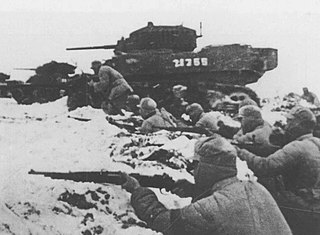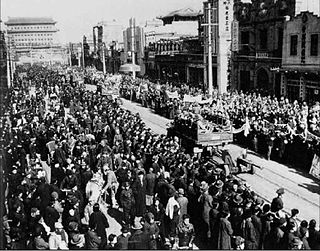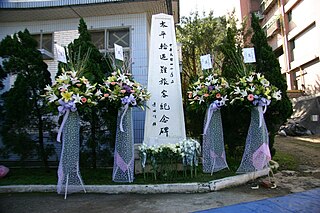 W
WThe Amethyst Incident, also known as the Yangtze Incident, was a historic event which involved the Royal Navy ships HMS Amethyst, HMS Consort, HMS London and HMS Black Swan on the Yangtze River for three months during the Chinese Civil War in the summer of 1949.
 W
WThe Battle of Kuningtou or Battle of Guningtou (Chinese: 古寧頭之役; pinyin: Gǔníngtóu zhī yì; Wade–Giles: Ku3-ning2-t’ou2 chih1 i4), also known as the Battle of Kinmen (金門戰役; Jīnmén Zhànyì), was a battle fought over Kinmen in the Taiwan Strait during the Chinese Civil War in 1949. The failure of the Communists to take the island left it in the hands of the Kuomintang (Nationalists) and crushed their chances of taking Taiwan to destroy the Nationalists completely in the war.
 W
WThe Huaihai campaign, or Battle of Hsupeng, was one of the military conflicts in the late stage of the Chinese Civil War between the Kuomintang and the Communist Party of China. The campaign started when the People's Liberation Army (PLA) launched a major offensive against the Kuomintang headquarters in Xuzhou on 6 November 1948, and ended on 10 January 1949 when the PLA reached the north of the Yangtze.
 W
WThe Pingjin campaign, also known as the Battle of Pingjin, was part of the three major campaigns launched by the People's Liberation Army during the late stage of the Chinese Civil War against the Nationalist government. It began on 29 November 1948 and ended on 31 January 1949, lasting a total of 64 days. This campaign marked the end of Nationalist dominance in the North China Plain. The term Pingjin refers to the cities Beiping and Tianjin.
 W
WThe founding of the People's Republic of China (PRC) was formally proclaimed by Mao Zedong, the Chairman of the Communist Party of China, on October 1, 1949 at 3:00 pm in Tiananmen Square in Beijing, the new capital of China. The formation of the Central People's Government of the PRC, the government of the new nation, was officially proclaimed during the proclamation speech at the founding ceremony.
 W
WThe Shanghai Campaign was a series of battles fought between the nationalists and the communists for the control of Shanghai, the largest city in China in the latter stage of the Chinese Civil War, and resulted in the city being taken over by the communists who enjoyed the numerical superiority.
 W
WThe Siege of Changchun was a military blockade undertaken by the People's Liberation Army against Changchun between May and October 1948, the largest city in Manchuria at the time, and one of the headquarters of the Republic of China Army in Northeast China. It was one of the longest campaigns in the Liaoshen Campaign of the Chinese Civil War.
 W
WTaiping was a Chinese steamer that sank after a collision with another vessel while en route from mainland China to Taiwan on 27 January 1949, killing over 1,500 people.
 W
WThe Taiyuan campaign was a campaign of the Chinese Civil War fought between the nationalist and communist factions. The campaign was over the control of Taiyuan, the capital of the province of Shanxi, China. The campaign resulted in a communist victory.
 W
WThe Yangtze River Crossing Campaign was a military campaign launched by the People's Liberation Army to cross the Yangtze River and capture Nanjing, the capital of the Nationalist government of the Kuomintang, in the final stage of the Chinese Civil War. The campaign began at night on 20 April, and lasted until 2 June 1949, concluding after the fall of Nanjing and Shanghai to the Communist forces.